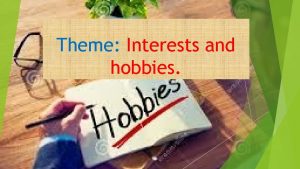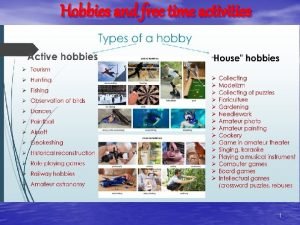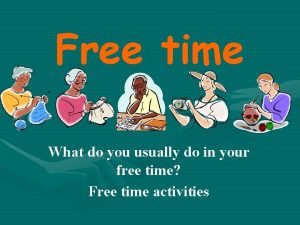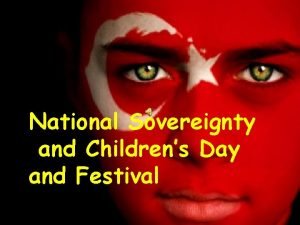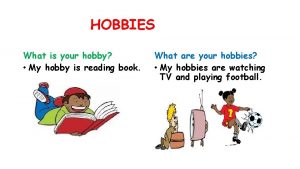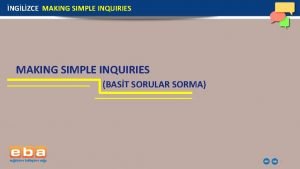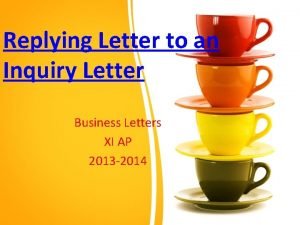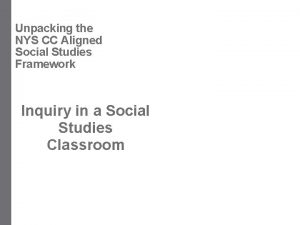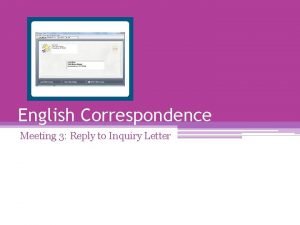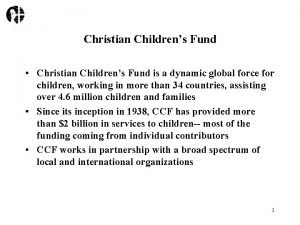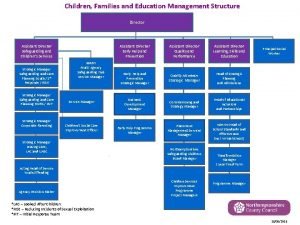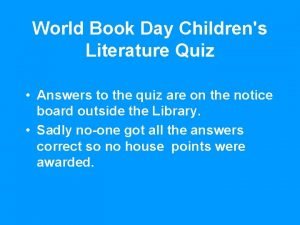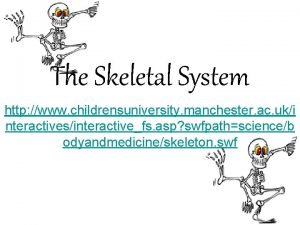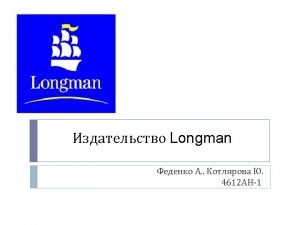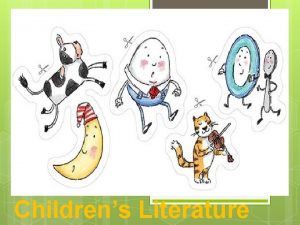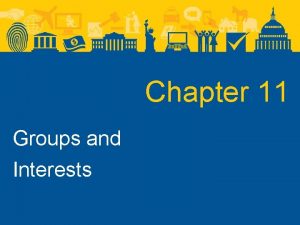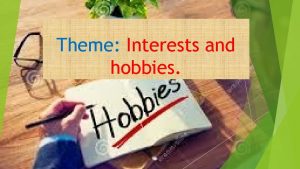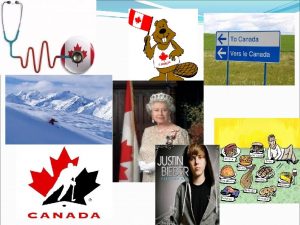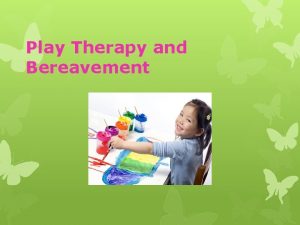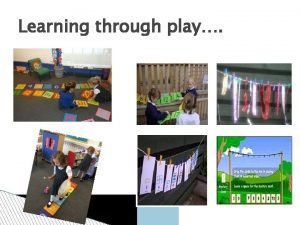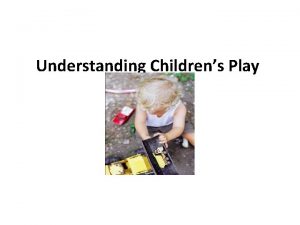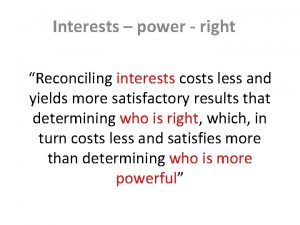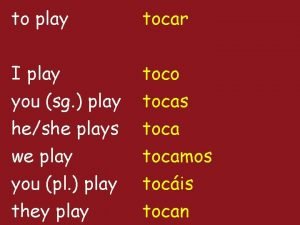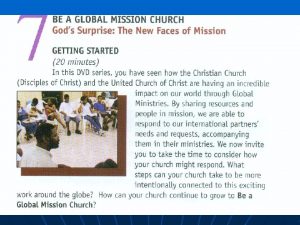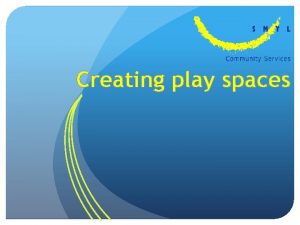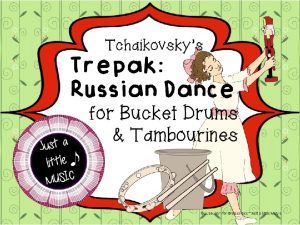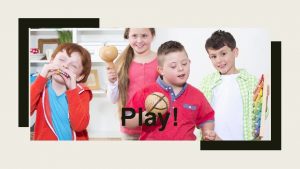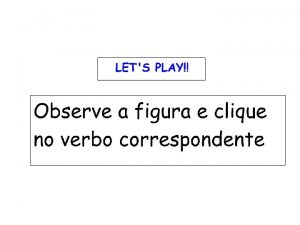Childrens interests and inquiries in free play activities

























- Slides: 25

Children’s interests and inquiries in free play activities Dr Elizabeth Wood Professor of Education, University of Sheffield Godly Play Conference 11. 5. 19



‘North West – our new beauty mogul’ The consuming and consumerised child Digital childhoods The free range child The always becoming adult child

Many different play types, forms and characteristics Two key concepts – free and structured play How these are understood in educational play, therapeutic play, sports, Godly play. What do children do in and with their play? What do adults do in and to children’s play?

Play should be seen as complex social and cultural activities, incorporating deep concerns with space, place, embodiment, emotions and temporality. Play is liminal: it occupies a threshold or space between reality and unreality, sense and nonsense, seriousness and playfulness, risk and safety, certainty and uncertainty, past-present-future. Play involves pushing boundaries (deep play, illicit/forbidden play, adventurous play, edge work, dizzy play, risky play). Play as learning, as disruption, as rebellion.

Play is not always ‘nice’, children do not always ‘play nicely’. ‘Folk play’; Halloween tricks and April Fool’s jokes; telling dirty rhymes, taunting, giggling, goofing off, doodling, whispering, teasing, bugging, making mischief, playfighting, stealing, vandalising, gambling, telling ghost stories, pulling pranks and making faces. (Sutton-Smith, 1997: 126). Finding the means and the time to disrupt and contest social order is revealed in the hidden transcripts of play. 7

Three concepts from contemporary research Working theories Children learning Funds of knowledge Children’s interests

Working theories • Although working theories are sometimes partial and emergent, they nevertheless are open to development and modification over time (Hedges, 2014 a). • Working theories are developed and expressed within children’s peer cultures as they collaboratively construct and share funds of knowledge, drawing on everyday events, popular culture and existential issues.

Working theories… represent the tentative, evolving ideas and understandings formulated by children (and adults) as they participate in the life of their families, communities and cultures and engage with others to think, ponder, wonder and make sense of the world in order to participate more effectively within it. Working theories are the result of cognitive inquiry, developed as children theorise about the world and their experiences. They are also the means of further cognitive development, because children are able to use their existing . . . understandings to create a framework for making sense of new experiences and ideas. (Hedges and Jones 2012, pp. 36 -37)

International research that focuses on the links between children’s interests, working theories and funds of knowledge explores how these combine to motivate learning (Gonzalez, Moll, & Amanti, 2005; Hedges, 2014 a, b). Funds of knowledge derive from diverse sources in children’s lives such as everyday events, popular culture and the media. Funds of knowledge reflect everyday social and cultural practices in children’s home and community lives (cooking, shopping, hobbies, work, family interests and activities)

International research that focuses on the links between children’s interests, working theories and funds of knowledge explores how these combine to motivate learning (Gonzalez, Moll, & Amanti, 2005; Hedges, 2014 a, b). Funds of knowledge derive from diverse sources in children’s lives such as everyday events, popular culture and the media. Funds of knowledge reflect everyday social and cultural practices in children’s home and community lives (cooking, shopping, hobbies, work, family interests and activities)

‘Harry Potter’ play (Jo Cook) 2. 0 Alice: He’s in his kennel … Hey Lucy, he’s going to come out. Hey come on dog, wake up. 3. 0 Alice assigns roles: You’re Hermione and I’m Hermione’s mum, and Richard is Hermione’s dad. I wonder why our dog has been so naughty. (To two boys) You two play about and eat sweets as bones. I need a doll. The boys play in role, hiding bones in the washing machine. Then Richard decides to join them as a dog, not as the dad, which gives rise to some re -negotiation of roles: Cg: Richard’s turned into a dog. Alice–Cg: But he can’t. Richard–Cgs I’m a doggy. Alice-SG: No turn him back to Hermione’s dad, we want somebody to marry. 6. 0 Cg–Cbs: Marry me marry me. Abracadabra. Make Richard turn into a boy.

The girls chase Richard around the role play area, with Alice again in control: Hey Lucy there’s a big surprise for you. These wands will turn Richard into a grown up … I’ve got off his doggy hair. Cb–Alice: I’ve put on real hair. Alice–SG: He’s standing up like a real person. 8. 0 The girls are getting really excited now and spoke in much louder voices: Cg–Alice: The spells aren’t working. Alice–Cg: I know, magic drink. They pick up bottles of coloured water and pretend to mix a drink.

The importance of magic as imagined power Invitations Invocations Incantations Fillet of a fenny snake, In the cauldron boil and bake; Eye of newt and toe of frog, Wool of bat and tongue of dog, Adder's fork and blind-worm's sting, Lizard's leg and owlet's wing, For a charm of powerful trouble, Like a hell-broth boil and bubble. Macbeth Act IV Scene 1

Knowledge is/as power The purposes of rules are intrinsic to the meaning of play: children test themselves against the rules. ‘Moral order’ is both external and internal to the play. Rules have specific meanings for ‘moral order’ in the context of play. Laundry Badminton Copenhagen Play Festival 2014

Michelle Hill (2015). Dead forever: Young children building theories in a play-based classroom (Unpublished Ed. D thesis, University of Sheffield)

Hill, M. and Wood, E. (2019) ‘Dead Forever’: an ethnographic study of young children’s interests, funds of knowledge and working theories in free play. Learning, Culture and Social Interaction, In Press • Death-rebirth, death and dying • Good and evil, bad/good, disobedience and punishment • Tools and equipment • Gender – what it means to be a boy/girl • Family roles and relationships • Babies and being a baby • Animals and being an animal • Search and rescue (after Christchurch earthquake, NZ) • Myths and legends, Disney, fairy and folk tales • Power and control – agency, what it means to be a child/adult • Knowledge and coming to know – sources of knowledge

A group of children have once again made a swimming pool using the brown foam building blocks. Jake (4: 11), Tracy (5: 6), Peter (5: 9), Chloe (5: 8), Rosie (5: 2) and Helen (5: 8) are playing and during the course of the play there is a change of focus and it becomes about dying and resuscitation. I observe the play and make notes. Jake: Pretend I died (he lies motionless face down on the floor) Tracy: Oh no! He’s died. Quick take off his gloves and shoes. (Jake is wearing a pair of goalkeeping gloves). (They lift him and move him over about 2 m) Tracy: Pretend I am the doctor Tracy: Helen: and Chloe: He’s dead. We have to wrap him up. He’s all white. His head is white, and his tummy is white, his feet arms are white. His bum is white Michelle Hill (2015). Dead forever: Young children building theories in a play-based classroom (Unpublished Ed. D thesis). Sheffield University, England.

Peter: I want to be dead (He lies down and Chloe, Helen and Rosie begin placing tissues over him. Jake remains motionless for a while longer then stands up and joins in) Tracy: Now me. Use the tissues on me (Helen covers Tracy’s face with a tissue) Cara: Can you breathe? Tracy: Actually don’t do my face. I don’t like it. I want to come back alive so I don’t want a tissue on my head. I don’t want to be dead forever. Tracy: (to Peter) Do you want to be dead forever? Peter: No Tracy: (addressing the others) Then don’t cover his face.

Adam: (to Michelle) Do you know the world’s greatest football player, he died and went to the doctor and the doctor electrocuted his heart and he became alive? He didn’t even come back alive by a ghost. Peter: That’s not true Adam: (to the researcher, his eyes are wide open as he speaks) He says that’s not true but my cousin told me. Peter: Sometimes people can be wrong Adam: Well even everyone in the world says it’s true. Later that day Adam’s mum tells Michelle that Adam’s older cousins have been to stay and had told him the news story about the footballer collapsing on the pitch and being revived using a defibrillator (the story had been headline news in the UK).

Children’s interests in spiritual and existential matters Working theories - being dead, coming alive, conditions that sustain life, deaths of pets and family members, funerals, What happens when you die, ‘who will look after me when you die? ’ - scientific, religious, cultural explanations. Zombies, ghosts, skeletons Funds of knowledge - popular culture, news and everyday events, myths and legends. Ethic of caring – self and others Hill, M. and Wood, E. (2019) ‘Dead Forever’: an ethnographic study of young children’s interests, funds of knowledge and working theories in free play. Learning, Culture and Social Interaction, In Press

The rhetorics of power and identity. . . autonomy, creative imitation - performance of the self-atplay and the playful self; symbols, meanings, rituals, imaginative capabilities. The importance of rules created by children in peer-led play. What lies behind the children’s interests – sustained enquiry and engagement with knowledge, sense-making, meaning, inquiry, coming to know and being knowledgeable.

Children affirm group and individual agency by acting with imagined power. (Wood, 2014) Children actively drive their own and each others’ development through observation and creative imitation, performing different roles and relating to others in ways that they are not yet fully capable of performing (Holzman, 2009). In play ‘children are capable of doing so much more in collective activity than in individual activity’ (Holzman, 2009, 30). Implications for Godly Play –on whose terms?

People are able to imagine things they never were and never will be. . . play should be understood as one of the special places for the conjuring of possibility. Thomas Henricks (2009)
 Hobbies and interests difference
Hobbies and interests difference Loosely organized groups who share interests and activities
Loosely organized groups who share interests and activities Questions about activities
Questions about activities What do you do in your free time?
What do you do in your free time? National sovereignty and childrens day
National sovereignty and childrens day Hobbies example
Hobbies example Making simple inquiries konu anlatımı
Making simple inquiries konu anlatımı Inquiry letter definition
Inquiry letter definition Hong kong airport advertising
Hong kong airport advertising Nys standards social studies
Nys standards social studies For inquiries please call or text
For inquiries please call or text Reply to quotation inquiry letter
Reply to quotation inquiry letter Reply to an inquiry letter
Reply to an inquiry letter Sas 99 inquiries
Sas 99 inquiries It is a popular indoor and outdoor sport
It is a popular indoor and outdoor sport Support activities and primary activities
Support activities and primary activities Primary activities and tertiary activities
Primary activities and tertiary activities Moli texas childrens
Moli texas childrens Christian childrens fund
Christian childrens fund Childrens services
Childrens services Walsall childrens services
Walsall childrens services Levine childrens
Levine childrens Multi agency assessment
Multi agency assessment World literature quiz 22
World literature quiz 22 Childrens university of manchester
Childrens university of manchester Longman picture dictionary
Longman picture dictionary
